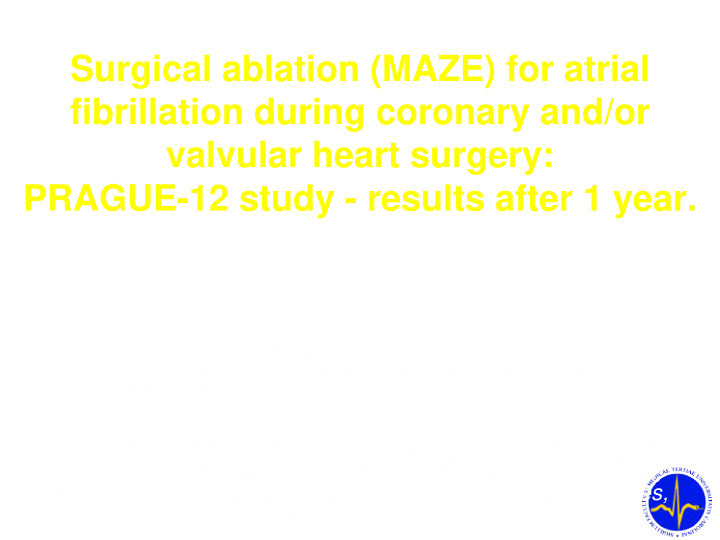



Surgical ablation (MAZE) for atrial fibrillation during coronary and/or valvular heart surgery: PRAGUE-12 study - results after 1 year. P Widimský, P Budera, Z Straka, P Osmančík, T Vaněk, Š Jelínek, J Hlavička, R Fojt, P Červinka, M Hulman, M Šmíd, M Malý Charles University Prague, Masaryk Hospital Usti nad Labem, Faculty of Medicine Pilsen, National Institute of Public Health, Prague, Czech Republic, National Institute of Heart Diseases, Bratislava, Slovakia .
Background. • Surgical atrial ablation procedure (MAZE) may restore sinus rhythm (SR) in pts with atrial fibrillation (AF) undergoing cardiac surgery. • Hypothesis (formulated by cardiac surgeons): (1) MAZE restores SR after surgery (2) without increasing perioperative complications (3) SR presence may improve long term outcomes.
Methods • Prospective randomized open multicenter study • Primary efficacy outcome: SR presence (without any AF episode) during 24-hours ECG after 1 year. • Primary safety outcome at 30 days: death / myocardial infarction / stroke / renal failure. • Main secondary outcome: composite of death, major bleeding, stroke or hospitalization for heart failure after 1 and 5 years.
Patients Inclusion criteria: • Heart team indication for cardiac surgery • AF documented at least twice in last six months - paroxysmal or (long standing) persistent • signed informed consent • age over 18 years. Exclusion criteria: • Emergent surgery 224 pts with AF scheduled for valvular and/or coronary surgery • MAZE group (left atrial surgical ablation, n=117) • Non-MAZE group (no ablation, n=107)
Baseline characteristic n (%) MAZE (n = 117) Non-MAZE (n = 107) Age (years) 69.9 ± 7.8 71.0 ± 7.9 Paroxysmal AF 26 (22.2) 33 (30.8) Persistent AF 30 (25.6) 25 (23.4) Longstanding persistent AF 61 (52.1) 49 (45.8) Atrial fibrillation just prior surgery 91 (77.8) 70 (65.4) Left atrial diameter (mm) 48.7 ± 7.3 47.7 ± 7.1 Mean NYHA functional class 2.3 ± 0.6 2.3 ± 0.7 Prior stroke / TIA 13 (11.1) 15 (14.0) Diabetes 41 (35.0) 40 (37.4) Prior major bleeding 4 (3.4) 6 (5.6)
Surgical procedure • Cryomaze (ATS) in 97% pts , radiofrequency in 3% pts. • Ablation time for each lesion 90 seconds. • Lesion set: pulmonary veins ablation, left atrial appendage exclusion and three interconnecting lesions • Epicardially or endocardially (based on whether LA is opened during the main surgical procedure)
Procedure types (all-comers with AF)
Sinus rhythm after 1 year (primary efficacy end-point, Holter 24-hour ECG) p = 0,194 p = 1.000 p = 0,002 p< 0,001
Evolution of sinus rhytm during 1 year (12-lead ECGs)
Perioperative complications Primary safety outcome (death / myocardial infarction / stroke / renal failure at 30 days) p = 0,411
Long-term adverse events (Death/ major bleeding/ stroke/ hospitalization for heart failure after 1 year) 45 p = 0,785 40 35 30 p = 0,680 25 p = 0,800 20 15 p = 0,654 10 p = 0,319 MAZE 5 Non-MAZE 0
Secondary outcomes at 1 year p=0,887 p=0,825 p=0,174
Conclusions (1) Surgical ablation improves the likelihood of SR presence up to 1 year postoperatively (2) Without perioperative complications (3) No impact on 1-year clinical outcomes Most significant rhythm benefit in pts with longstanding persistent AF (no benefit seen in paroxysmal AF).
Back-up slides for discussion
Non-MAZE (n = Proceduralcharacteristics MAZE (n = 117) p-value 105) Duration of surgery (min) 220 (180-255) 200 (165-240) 0.003 Cross-clamp time (min) 78 (46-96) 51 (31.5-73) <0.001 Postoperative sinus 69 (59.0 %) 79 (75.2 %) <0.001* rhythm Postoperative atrial 12 (10.3 %) 16 (15.2 %) fibrillation Postoperative epicardial 36 (30.8 %) 10 (9.5 %) stimulation Blood loss (ml) 680 (450 1115) 705 (445 945) 0 565
Chronic preoperative medication Beta-blocker 90 (76.9) 85 (79.4) Amiodaron / Propafenon 22 (18.8) 19 (17.8) Digoxin 30 (25.6) 24 (22.4) Warfarin 81 (69.2) 69 (64.5) Aspirin 41 (35.0) 33 (30.8)
Treatment strategy during follow-up • Visits after 1, 3, 6 and 12 months • Postoperative care identical for both groups • Amiodarone (or propafenone or sotalol) since the day of surgery • Warfarin with target INR 2-3 • Other medication (incl. betablockers) individualized • Antiarhythmic drugs discontinued 3 months after surgery if no AF episode documented • Warfarin discontinued after 6 months if SR persists • DC cardioversion recommended if AF present at 30 days
Patients follow-up
30-day outcomes MAZE (n = 116) Non-MAZE (n = 102) p-value Revision for bleeding 10 (8.6 %) 9 (8.8 %) 1.000 Other major bleeding 5 (4.3 %) 6 (5.9 %) 0.759 complication Respiratory insufficiency with 3 (2.6 %) 8 (7.8 %) 0.119 reintubation Heart failure with 14 (12.1 %) 14 (13.7 %) 0.840 rehospitalization Pacemaker implantation 7 (6.0 %) 1 (1.0 %) 0.070 Death 9 (7.8 %) 9 (8.8 %) 0.809 Myocardial ischemia 2 (1.7 %) 2 (2.0 %) 1 Stroke 2 (1 7 %) 4 (3 9 %) 0 422
Post-operative antiarrhytmic medication MAZE Non-MAZE p-value Discharge, n (%) n = 111 n = 100 beta-blockers 64 (58%) 67 (67%) 0.162 antiarrhythmics 91 (82%) 76 (76%) 0.285 digitalis 9 (8%) 7 (7%) 0.761 Day 30, n (%) n = 107 n = 93 beta-blockers 74 (69%) 69 (74%) 0.431 antiarrhythmics 80 (75%) 62 (67%) 0.207 digitalis 10 (9%) 6 (7%) 0.451 Year 1, n (%) n = 93 n = 76 beta-blockers 67 (72%) 59 (78%) 0.406 antiarrhythmics 29 (31%) 17 (22%) 0.200 digitalis 10 (11%) 12 (16%) 0.333
Recommend
More recommend